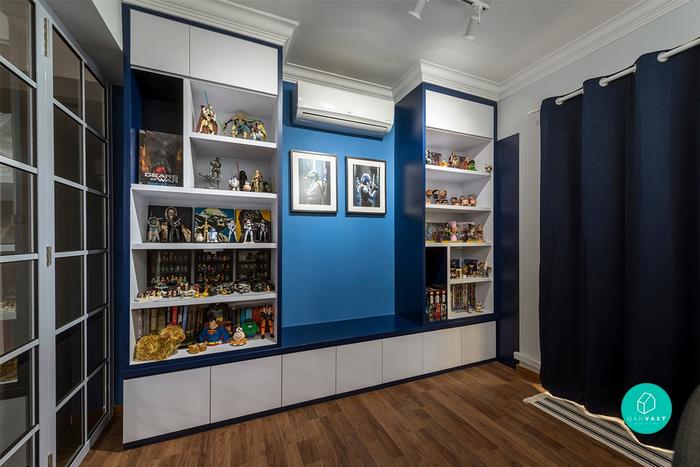For something that’s almost a necessity in sultry Singapore, air-conditioners are still very much a mystery to us. Sure, we probably know the basics of picking the right air-con, but anything more? Well, best to leave it to the cooling experts, eh?
But here's the thing - installing an air-con doesn't just take up a chunk of time and cost, but also a ton of effort. Extensive structural works are often required, and one wrong move can seriously affect how well an air-con works in the long run. So, if you are going to get it - do it right the first time around. Here are 5 important details every homeowner should look out for when setting up an air-conditioning system in a HDB.
1. Your HDB’s Electrical Supply Rating

Interior Designer: DB Studio
This is especially so for HDBs, which have limitations in their Incoming Electrical Supply. Older HDB apartments (usually those built before 1994) use a smaller, 230V/30A supply, while newer flats come with 230V/40A, which allows a bigger cooling capacity - like having 4 split units (System 4) in one apartment.

Interior Designer: IDID
So, what happens if you are installing an air-con in a pre-1994 HDB? You may need to apply for a permit to install your AC. Also, you’ll need to make sure that the air-con model that you choose does not exceed the supply ratings. There’s a limit to the maximum total running current allowed in each home.

For instance, the maximum allowed air-con current for an older, 3/4/5-room or executive maisonette flat is 8.5A. This means the combined input current (whether it’s for one or multiple split units) cannot exceed 8.5A. Do consult with an air-conditioning expert the types of AC models available for your input current limit.
2. Where You’re Installing Your Air-Con Unit

Interior Designer: Colourbox Interior
While there are no limitations as to where you’d like to install an air-con unit, it’s placement will affect how well it cools the air around you. As a rule of thumb, place it at a location that’s free from obstructions – so as to allow cool air to have enough space to circulate.

Interior Designer: DB Studio
If possible, avoid installing a unit by the corner of a room with walls/pillars blocking it. This lack of ventilation space will create ‘hot spots’ in the long run, which could reduce an air-con’s cooling efficiency and cause it to easily break down.
Another rule to note? Keep your ACs away from other electronic devices like routers, security cameras and antennas as electrical feedback may interfere with the signals on your split air-con system.
3. How High You’re Installing Your Air-Con Unit

Interior Designer: MMJ Design Loft
Once you’ve figured out where to place it, it’s time to think how high you’d like to install your air-conditioner. The perfect, Goldilocks height? 2.2 metres from the under side of the air-con unit to the finished floor level for HDBs.

Interior Designer: Fineline Design
Considering a typical HDB flat’s floor-to-ceiling height is about 2.8m and the average human height tops off at about 1.8m (in this part of the world), 2.2m is just high enough to blast cool air out – without blowing directly in people’s faces – and low enough to circulate cold air efficiently. In fact, any space above 2 metres is not required to be cooled, as cold air sinks and hot rises.
4. Doing Post-Installation Tests and Checks

Interior Designer: Free Space Intent
Now, time to get the installation works up and running! You should only engage a BCA-certified professional to install your air-con. However, that does not guarantee the quality of works, unfortunately.
In fact, besides the main fan coil split unit, don’t forget to check these 4 air-con components during installation to ensure that they are set up properly as well:

- The Refrigerant Pipe: It should be of the length specified by the manufacturer and not be too short that the refrigerant is unable to cool down or expand. This can result in a drop in cooling capacity, and damage the outdoor compressor. Also, check that joints are properly glazed and there are no cracks.

- The Condensate Water Pipe: This pipe helps to drain away water caused by condensation. The pipe should have a sloped gradient for the water to flow and drain out smoothly. Likewise, check that joints are not loosed or cracked.

- Insulation for Refrigerant and Condensate Pipe: Insulation tubes help to prevent leakages and minimize the loss of energy. So, make sure the correct thickness is used to insulate both pipes. The recommended thickness is usually 1/2" (Class 0), though 3/8" thickness (Class 1) also works just as well.
- Location of Outdoor Condenser: While there’s usually an air-con ledge or supporting brackets to hold up your outdoor condenser in a HDB, always make sure there’s enough ventilation and space for future servicing.
5. Other Design Details to Look Out

Interior Designer: LLARK Architects
Lastly, thinking of concealing your unsightly split AC behind a false ledge or a concealed compartment? It's advised to best avoid such details - for the sake of your air-con’s performance. As mentioned, these features serve as ‘obstructions’ which block the cool air from properly circulating about the rest of the space - and can cause your air-conditioner to work harder than it should.

 Get a budget estimate before meeting IDs
Get a budget estimate before meeting IDs